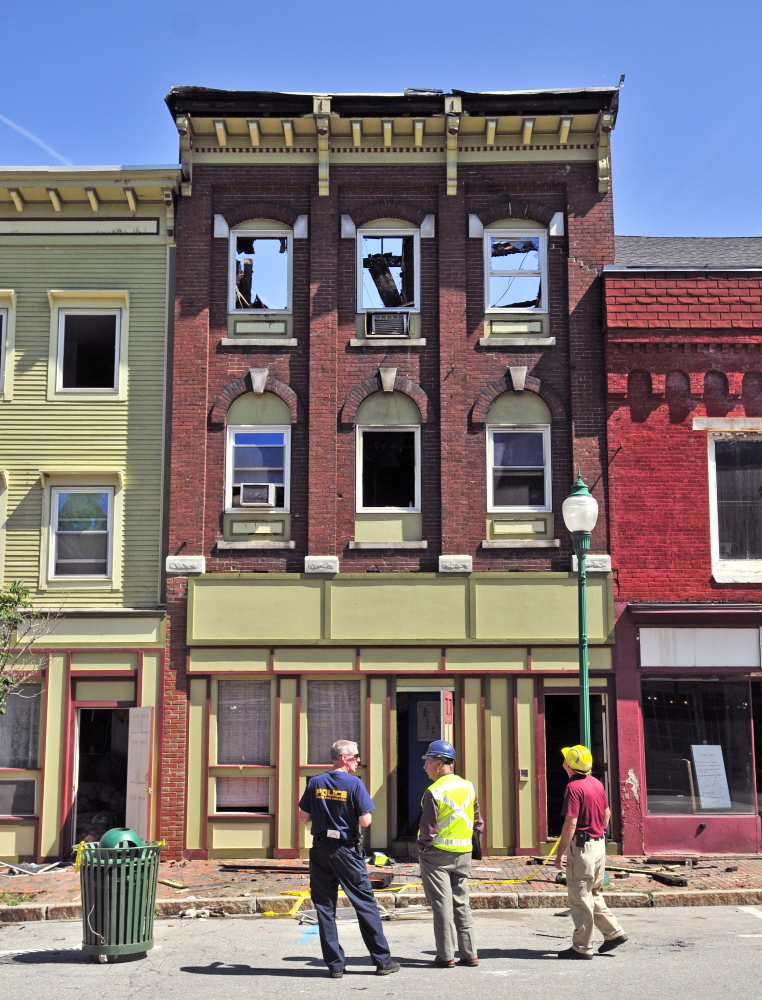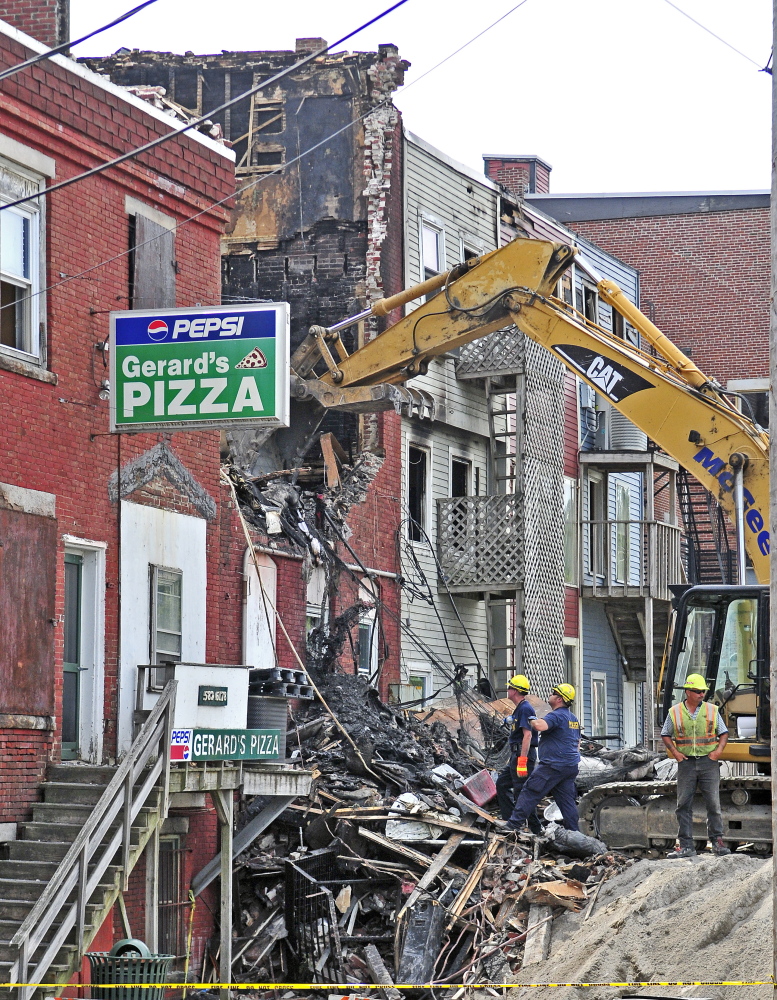GARDINER — From most of Water Street, it’s not clear a fire gutted two buildings in the city’s historic downtown district a little over a week ago.
The building facades survived, but the July 16 fire destroyed part of a roof and workers tore down half of its rear wall with a backhoe, giving a clear view of the sky through the windows on Water Street.
Although what will happen to the buildings, or even when something might happen, isn’t known, community members and those involved in the downtown say they hope the burnt-out buildings don’t become a black eye for the downtown or are simply torn down and turned into another park.
The head of Gardiner Main Street, a downtown revitalization organization, said it will be up to the two building owners and their insurance companies to decide what to do with the buildings, but he hopes they can be saved.
“I view our historic buildings as our greatest asset, one of our greatest assets, to build and to grow,” Executive Director Patrick Wright said from his Water Street office last week. “If we were to lose those, that would present a challenge.”
He said the effort to revitalize the downtown would be able to overcome the loss of buildings, but it would mean a drop in the downtown’s precious inventory of historic buildings.
“Those buildings were built in the late 1800s,” Wright said of the damaged buildings. “They don’t build them like that anymore.”
The fact that the buildings are considered historic and are part of the downtown district listed on the National Register of Historic Places may provide avenues and funds for rebuilding that wouldn’t otherwise be available.
If the buildings are found to be eligible, federal and state historic tax credits may be available to reimburse 45 percent of any reconstruction costs. And if the buildings keep their historic status, they could be rebuilt in the federal flood zone without meeting the flood-proofing standards required of new buildings built in flood zones.
Although the structures may be exempt from the floodplain requirements, the Federal Emergency Management Agency, which oversees the federal flood insurance program, advises that flood mitigation efforts should be considered when rehabilitating a historic structure.
Maine Preservation, a Yarmouth-based nonprofit organization that works to preserve historic places in the state, sent a consultant to Gardiner soon after the fire to work with officials evaluating the buildings. In order to remain eligible for historic building benefits, structures need to have at least 75 percent of their walls intact, said Greg Paxton, executive director of the organization.
It appears the damaged buildings in Gardiner would still be eligible for the tax credits, but it’s too early in the process to determine that, Paxton said.
The owners of the buildings either declined to comment or couldn’t be reached.
Paul McGuire, who owns the building at 247 and 249 Water St., declined to comment when reached by phone Friday morning at O’Connor Auto Park in Augusta, where he is general manager. The building, along with 251 Water St., is currently listed for sale by Magnusson Balfour Commercial and Business Brokers in Portland.
Wright said Wayne Chamberlain, who lives in Connecticut, owns the building at 235 Water St., which has two separate facades and is where officials believe the fire originated in one of the 12 residential units. Wright reached out to Chamberlain on behalf of the Kennebec Journal, but Chamberlain didn’t respond to the paper’s request for a comment.
A tattoo studio, Touch of Grey Tattoo, opened earlier this month at 247 Water St. The studio, which temporarily moved back to its former location on Maine Avenue in Farmingdale, is raising money online to replace lost equipment and to reopen.
If the buildings end up being torn down, Clare Marron, a downtown business and building owner, said she hopes it happens sooner rather than later.
Marron and her partner live above her art gallery and shop, Monkitree, on the same block as the damaged buildings. She said she would prefer the building remain available for residential and business tenants. By eliminating a block of buildings, it’s eliminating a block of potential customers for downtown businesses, she said.
“We have a downtown that people come to for the first time and say, ‘This is a special place.’ I would hope that we could maintain that feeling in our downtown,” Marron said, “whether that happens by saving those buildings or doing something new.”
George Trask, a former city councilor, is skeptical the buildings will be rebuilt. The longtime Gardiner resident said that if the buildings are torn down as he expects, he hopes the city can build a small parking garage in their place — anything but another park, he said.
“I’d hate to see a big hole in the middle of Water Street, but I don’t know what else to do,” Trask said.
In 1985, a fire destroyed a block of buildings toward the Bridge Street end of Water Street. Now, in the gap created by the fire, there is green space and a walkway named McKay Park.
Although Trask has been at times critical of downtown revitalization efforts, he said he’s optimistic about the city’s future and thinks it’s been heading in the right direction. The fire sets that back a bit, he said.
But Wright, who also serves as the city’s economic and community development coordinator part time, said he doesn’t see the fire as a setback.
“I’m more convinced today than I was a week ago on the spirit of this community and its ability to rally around its historic architecture, its business community and its downtown,” Wright said Wednesday.
He said the community response, which included a silent auction at Monkitree and several other fundraisers, shows that downtown Gardiner matters to not just people in the city but to people in the surrounding region.
If the fire happened 10 or 15 years ago, it would have been a lot more of a blow, Wright said. The community, buoyed by a two-year planning project completed about a year and a half ago, now believes in itself more, he said.
Since last year, a downtown business incentives program funded by the Bank of Maine, community groups and the city attracted two Maine businesses, Frosty’s Donuts and Emery’s Meat & Produce, and the program recently approved funding for a craft beer store that’s expected to open on Water Street in late August. The Gardiner Food Co-op & Cafe, a long-term goal of a local food group, also opened in the downtown this spring.
“I think because this is in concert with our growth and the advances we’ve made, it makes us stronger,” Wright said. “But I could see how something like this could be a devastating setback if you’re not prepared for it.”
Paul Koenig — 621-5663
Twitter: @pdkoenig
Send questions/comments to the editors.




Comments are no longer available on this story